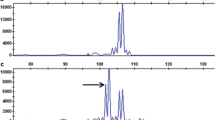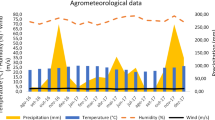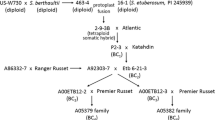Abstract
ASolatium tuberosum L. gp.tuberosum population was subjected to 2 cycles of phenotypic recurrent selection for resistance to the potato leafhopper,Empoasca fabae (Harris), as expressed by low levels of nymph infestation. Samples of lines from the original population and from the cycle 2 population were tested for infestation levels at 2 locations for 2 years. Infestation in cycle 2 lines was 54% lower than that in lines from the original, unselected population.
Resumen
Una población deSolanum Tuberosum L. gp.Tuberosum fué sometida a dos ciclos de selección fenotífica recurrente para resistencias a cigarrita de la papa, Empoasca fabae (Harris) expresada por la baja infestación de ninfas. Muestras de la población original y de la población con 2 ciclos de selección fueron evaluados con los niveles de infestación en 2 localidades por dos años. La infestación de líneas del segundo ciclo fue 54% menor que aquellas de la población original no seleccionados.
Similar content being viewed by others
Literature Cited
Hibbs, E.T., D.L. Dahlman, and R.L. Rice. 1964. Potato foliage sugar concentration in relation to infestation by the potato leafhopper,Empoasca fabae (Homoptera:Cicadellidae). Ann Entomol Soc Am 57:517–521.
Horsfall, J.G., and R.W. Barratt. 1945. An improved grading system for measuring plant diseases. Phytopathology 35:655.
Milthorpe, F.L. 1963. Some aspects of plant growth, p. 13–14. In The growth of the potato, Eds. J.D. Ivins and F.L. Milthorpe. Butterworths, London.
Sanford, L.L., and J.P. Sleesman. 1970. Genetic variation in a population of tetraploid potatoes: Response to the potato leafhopper and the potato flea beetle. Am Potato J 47:19–34.
Sanford, L.L., and J.P. Sleesman. 1974. Selection for resistance to potato leafhoppers in potatoes I. Selection methods. Am Potato J 51:44–49.
Sleesman, J.P. 1945. Search for a leafhopper resistant potato. Ohio Agric Exp Stn Bull 659:114–115.
Sleesman, J.P., and F.J. Stevenson. 1941. Breeding a potato resistant to the potato leafhopper. Am Potato J 18:280–298.
Tingey, W.M., and R.L. Plaisted. 1976. Tetraploid sources of potato resistanceto Myzus persicae, Macrosiphum euphorbiae, andEmpoasca fabae. J Econ Entomol 69:673–676.
Author information
Authors and Affiliations
Rights and permissions
About this article
Cite this article
Sanford, L.L., Ladd, T.L. Selection for resistance to potato leafhopper in potatoes. II. Progress after two cycles of phenotypic recurrent selection. American Potato Journal 56, 541–547 (1979). https://doi.org/10.1007/BF02855969
Received:
Issue Date:
DOI: https://doi.org/10.1007/BF02855969




